AMD Ryzen Threadripper Pro 5995WX WEPYC Performance
Since so many folks love to discuss Cinebench with AMD CPUs, given how well AMD performs on it, here is a shot loading all 128 threads on Cinebench R23.
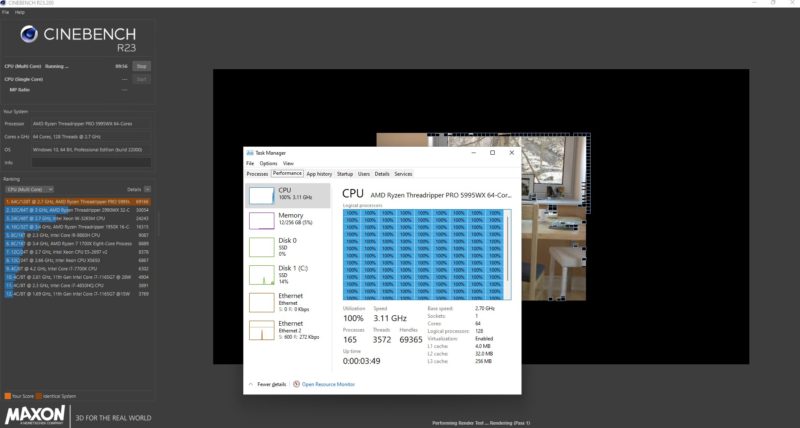
Still, when it came time to pick a benchmark comparison set, it felt like there was really a single competitor in the workstation market, and that was the Threadripper Pro 3995WX. As a result, we re-ran the benchmarks, albeit on the Supermicro rather than the Lenovo system, from that review and added a few of the newer workloads that we have been running since that time. We wanted to show the generational difference between the two CPUs since they really dominate the market. There are no other CPUs in the workstation market that have >41 cores at this time in a single socket.
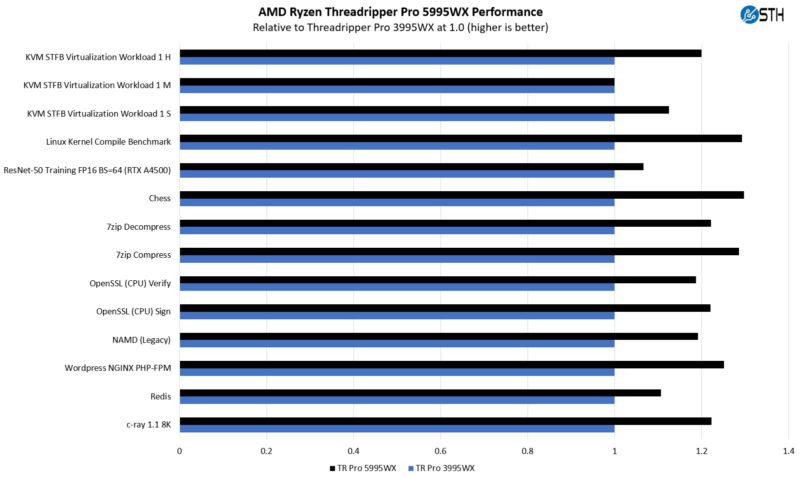
The key here is that the systems are generally 20-30% faster in most workloads. In some, they are significantly less like when we use ResNet-50 training and the A4500 GPU. Most of the workload is GPU accelerated so we see a more muted benefit. Also on the medium virtualization test, the increased performance did not get us an additional VM as it did in the other size KVM virtualization tests so it shows no performance gain. That is just a sizing quirk, but overall, the 5995WX is superior to its predecessor, even if the core counts have not changed.
On the power consumption, we saw power levels about 10% higher than a similarly configured 3995WX in the Lenovo P620. Expect even without high-end GPUs, NICs, or storage, you will be able to push systems with cooling to ~500W at the wall. We also did not have the same 3995WX and 5995WX systems due to the ThinkStation P620 getting misplaced in FedEx Memphis. Still, we are getting more performance than we are consuming more power, so this is generally an acceptable trade-off.
Next, let us get to the platforms.
AMD Ryzen Threadripper Pro 5995WX WEPYC Platforms
We are going to take a quick look at two platforms we have been using for the Threadripper Pro launch, one motherboard from Gigabyte and one complete system from Supermicro.
Gigabyte MC62-G40 Threadripper Pro Motherboard
The Gigabyte MC62-G40 is a motherboard based on the Threadripper Pro family. In contrast to Lenovo’s approach with the ThinkStation P620, Gigabyte sells not just a workstation, but also a server and the bare motherboard for Threadripper Pro.
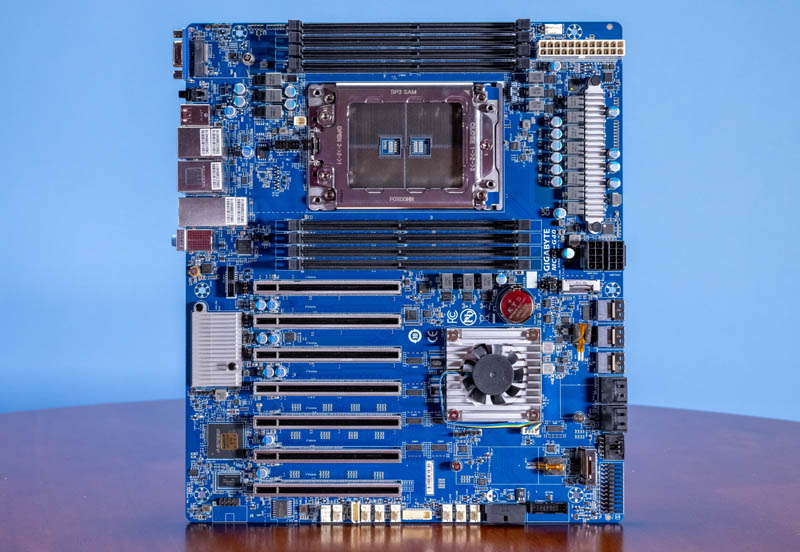
The Gigabyte MC62-G40 supports both the new Threadripper Pro 5995WX as well as the 3995WX and lower-end SKUs. It offers the same set of 8x DIMM channels for 1DPC operation we see in other platforms.
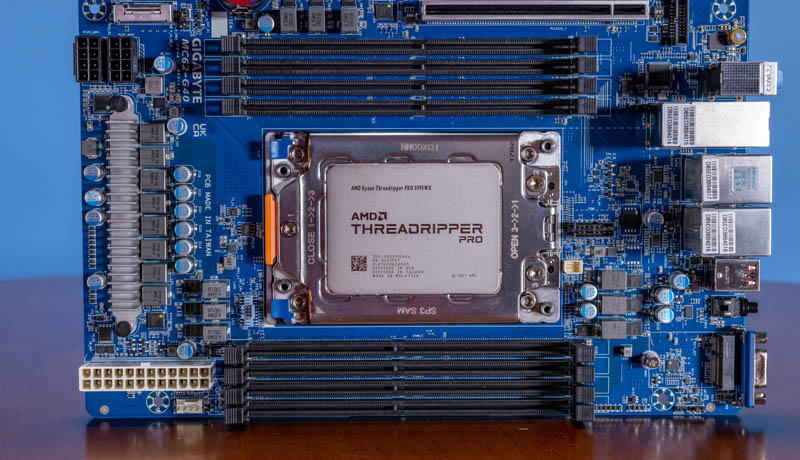
Perhaps one of the items that makes each vendor’s platform with Threadripper Pro unique is the PCIe slot and WRX80 configuration. Each vendor has a lot of lanes to work with on Threadripper Pro and the chipset adds another layer of connectivity.
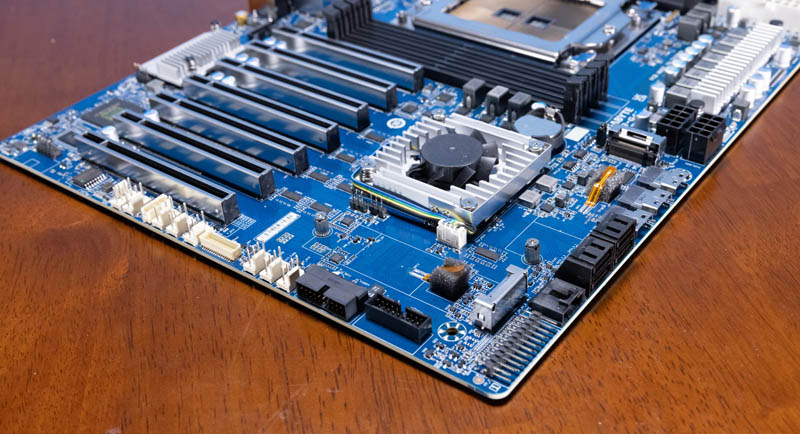
This is the motherboard’s block diagram. We can see six of the seven slots are full PCIe Gen4 x16 slots. The other is x8. Based on Milan, we should have around 128 PCIe lanes to work with and that is 104 just in PCIe slots. There are another 8 lanes dedicated to the dual M.2 slots for 112.
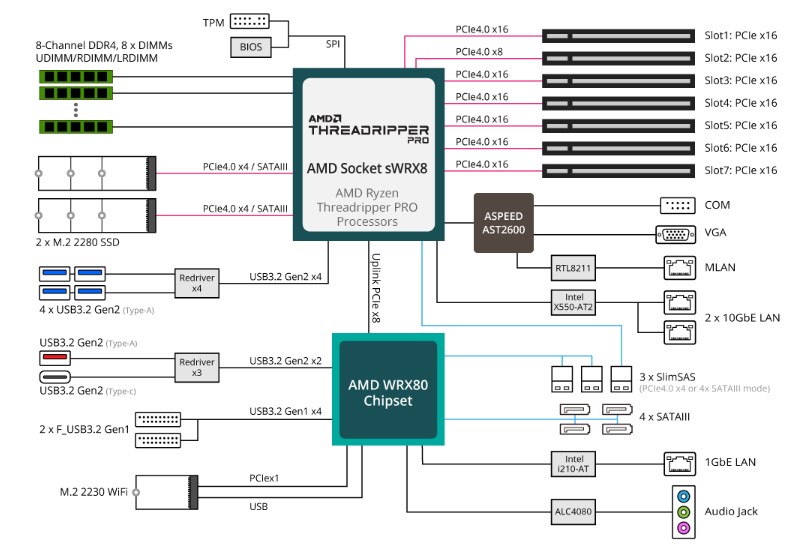
From here, eight lanes are dedicated as an uplink for the WRX80 chipset (120.) The chipset has the SATA lanes as well as 1GbE LAN, the M.2 WiFi slot, audio, and USB ports. The remaining lanes in the platform are being used for other miscellaneous connectivity. Gigabyte is maximizing the Threadripper Pro platform.
Supermicro AS-5014A-TT Threadripper Pro Workstation
The Supermicro AS-5015A-TT is a fully configured workstation. This is roughly equivalent to the ThinkStation P620 that Lenovo sells, and we reviewed last time. It is also quite different to both the Lenovo platform as well as the Gigabyte motherboard platform shown above.

One of the really interesting points of the system is that it is liquid-cooled. If you saw our recent How Liquid Cooling is Prototyped and Tested in the CoolIT Liquid Lab Tour piece, you will be aware that next-gen servers will need liquid cooling. Supermicro is on that trend with 280W TDP Threadripper Pro parts here. Expect this trend to continue in future generations as well.
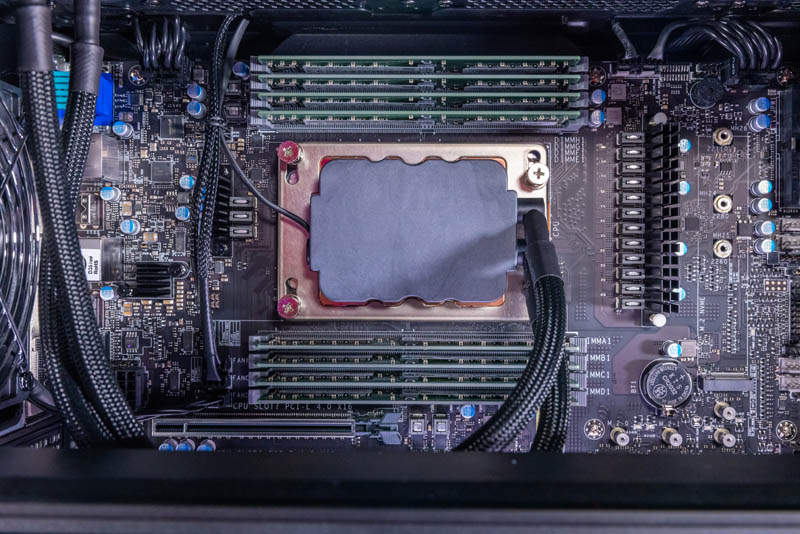
Aside from the eight DIMM slots, Supermicro has a larger motherboard, and therefore has a bit of a different methodology than Gigabyte. We get six PCIe Gen4 x16 slots, but instead of a seventh slot, that would often be covered by a dual-width cooler, Supermicro does something different.
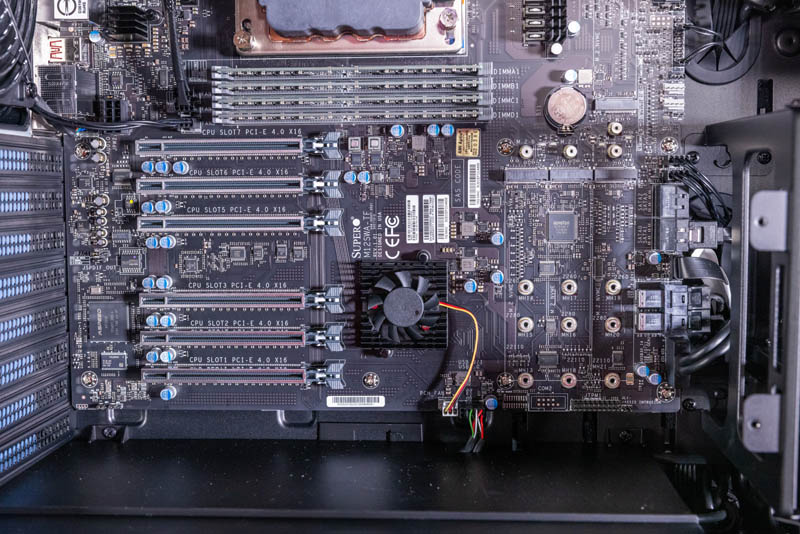
Supermicro has four M.2 slots for internal storage. One can also see four SATA slots to connect to the front 2.5″ swappable bays, as well as two U.2 ports on the motherboard that we have connected to two Kioxia CD6 NVMe SSDs.
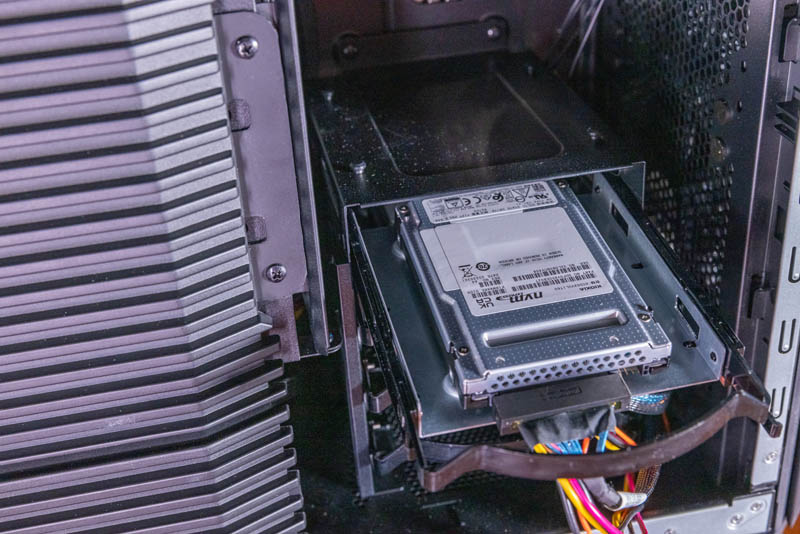
The missing slot is important because many of the professional NVIDIA GPUs, like the line formerly called “Quadro”, are double-width GPUs. PNY sent this NVIDIA RTX A4500 20GB card to use with our Threadripper Pro testing, and that is a great example of a double-width card that Supermicro has its PCIe slot layout designed for.
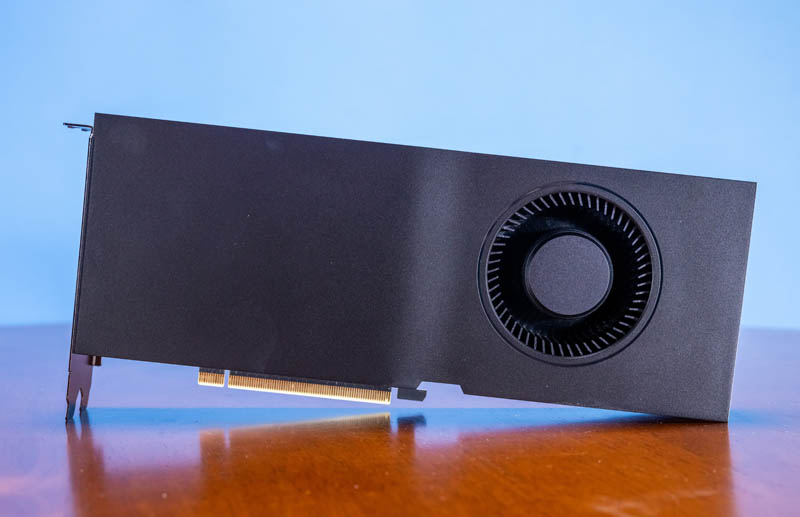
Before getting to the block diagram, we wanted to show something quickly, and that is the BIOS that came in our system. This is a version 2.0 BIOS system from 2022-02-25. Even though the DIY market for these CPUs just started in late June. This was a BIOS update from the previous generation, yet AMD still gave certain OEMs exclusive early sales access to the parts. These platforms have been ready for some time.
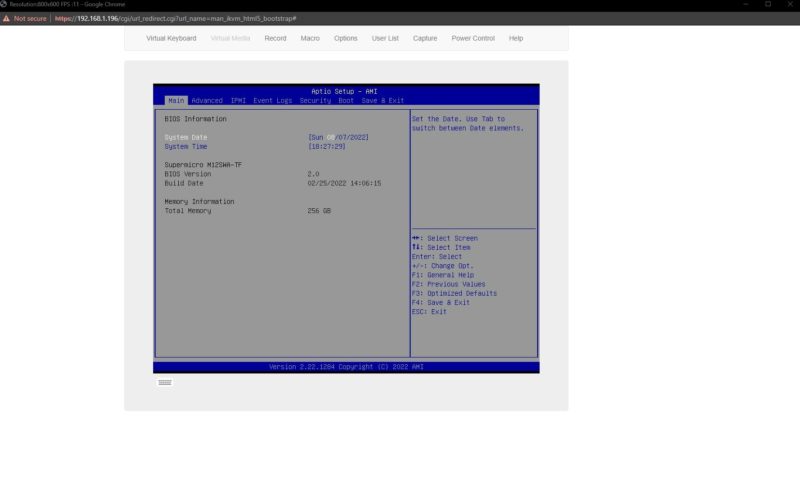
One other small feature that we normally do not cover, but we have gotten questions on, is whether you can install Windows using AMD chipset RAID. We saw this going through the BIOS is this UEFI boot entry is exactly that. AMD RAID booting Windows.
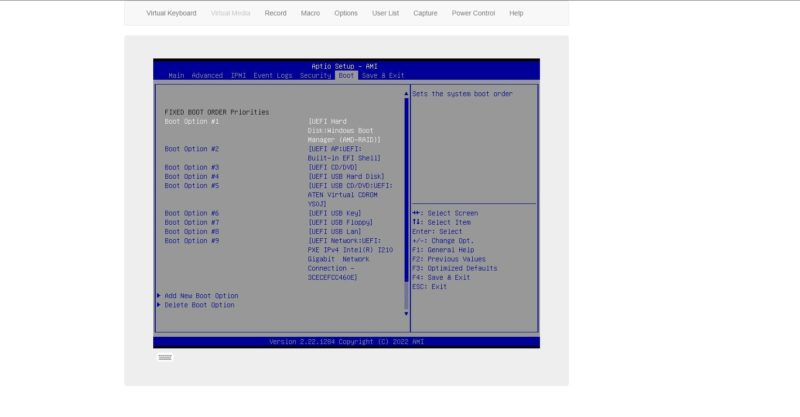
On the motherboard block diagram, we can see that Supermicro is prioritizing the M.2 slots over a seventh PCIe slot. Also, Supermicro has quite a bit of the I/O coming off of the CPU. Like other platforms, this has very high PCIe lane utilization.
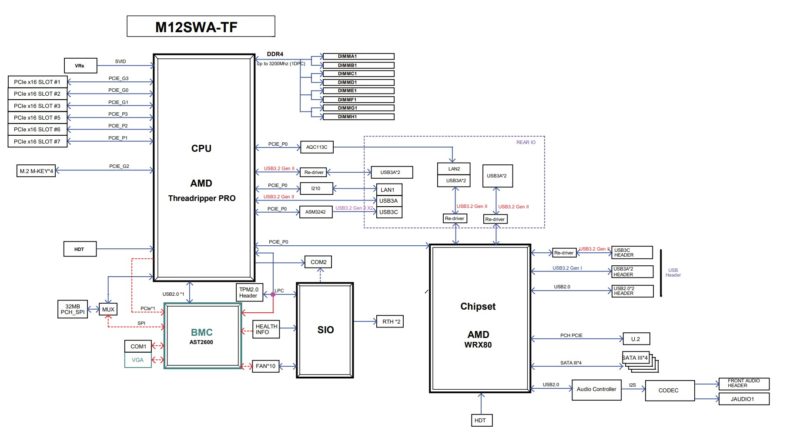
We also see the ASPEED AST2600 BMC. One of the great features of these Threadripper Pro platforms is that they are built like the old dual Xeon workstations of old in this regard. With the BMC, a nice feature is that today’s workstation can easily transition into tomorrow’s workgroup server.
Next, let us get to the market impact and the key lessons learned.

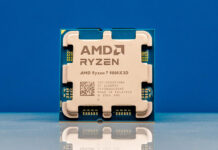
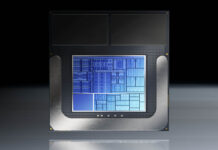

280W TDP is hard to accept for a 12-32 Core nowadays. Would be interesting how the average power uptake is in tests!
can you check if PBO is available in the bios as asrock and msi wrx80 mobos ? Asus does not have it and it is not mentioned for supermicro and gigabyte….
Pricing is utterly horrific for someone that just wants a desktop platform with lots of PCIe and a fair amount of RAM. Still nothing worth upgrading a 1900X to
Every use case I can think of has a cheaper solution. The performance difference between the i9 and this new threadripper isn’t worth $5,000 to me.
There are plenty of used server and workstation hardware on the market that can provide 60-70% of the core performance for less than 30% of the price. If you need value,look somewhere else than this.
Is there anyone else that has trouble opening pictures that are using link in the form /?attachment_id=6xxxx
What I find really interesting is the fact that both Gigabyte and Supermicro are using server grade components, and Lenovo do not.
For instance both platforms described here are equipped with BMC and NICs with better support in the DC. With Lenovo we are not getting such features.